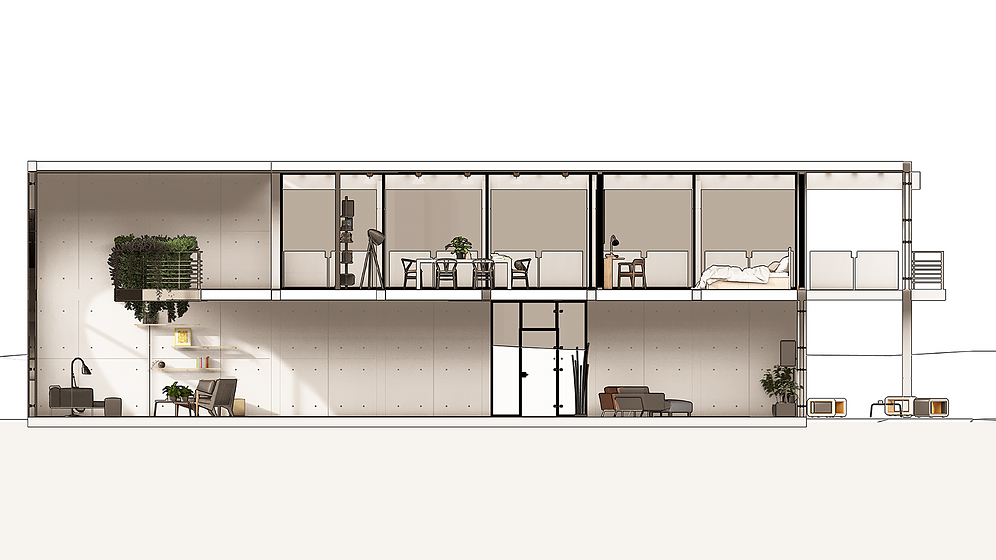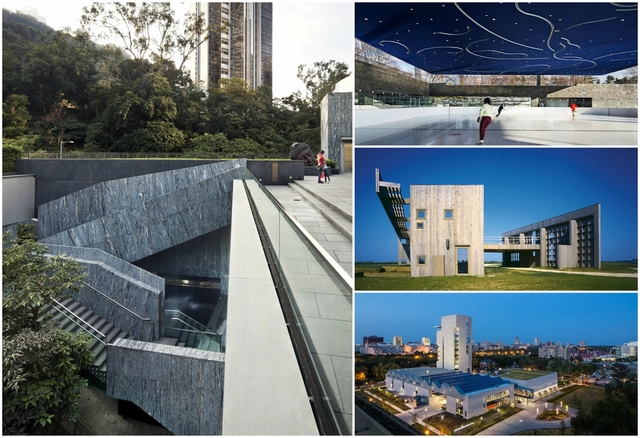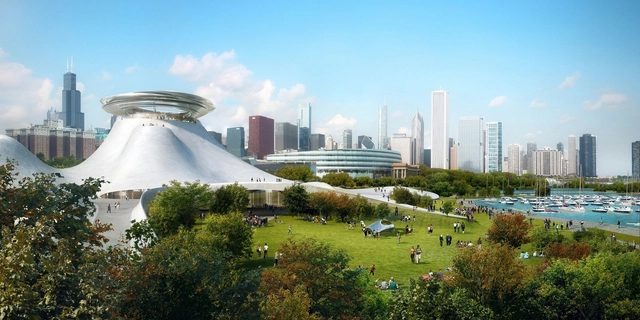
Produce personalized presentation boards that distill complex concepts into simple visual representations with a few helpful tools and effects.


Produce personalized presentation boards that distill complex concepts into simple visual representations with a few helpful tools and effects.

Zeller & Moye, working alongside artist Albert Weis, have been selected to design the new Martin Luther Memorial in Berlin. The competition, initiated by the Protestant Church of Berlin and the Berlin City Administration, asked entrants to design a memorial to Luther in central Berlin at the former Neuer Markt next to the St. Marienkirche—in the same location as a previous memorial to Martin Luther that was constructed in 1895 and destroyed in the Second World War. The brief also required designers to incorporate the existing statue of Martin Luther that survived from the earlier memorial.
In response to this brief, Zeller & Moye has envisaged a memorial based on the mirroring of the 1895 memorial: a negative form of the original plinth is carved into the ground in medium-gray concrete, while the statue of Luther is joined by a second, slightly abstracted replica, cast in aluminium with a mirrored finish.

The World Architecture Festival have announced the shortlist for their 2016 awards, featuring 343 projects from 58 countries across 32 categories. As the world's largest architectural awards program, the shortlist contains completed and future projects from every corner of the globe.
All finalists will be invited to present their project live at the festival in November at the Arena Berlin in Germany to a "super jury" that will include Kai-Uwe Bergmann (BIG), Louisa Hutton (Sauerbruch Hutton), David Chipperfield, Ole Scheeren, and ArchDaily's co-founder and Editor-in-Chief David Basulto. A winner for each of the awards' 32 categories will be selected. From this, an overarching World Building or Future Project of the Year award will be selected. Tickets for the festival can be booked here.

It's graduation time. As universities around the globe - or at least most in the Northern hemisphere, where over 80% of the world's universities are located - come to the end of the academic year, many university architecture studios have recently closed out the construction of pavilions, installations and other small educational projects. Last year at ArchDaily, with the help of our readers, we were able to round up some of the best pavilions, installations and experimental structures created by students from all over the world. The resulting article was among our most popular of the year, demonstrating people's huge appetite to see the work of the next generation of young architects.
That's why we're once again teaming up with all of ArchDaily en Español, ArchDaily Brasil, and ArchDaily China, asking our readers to submit their projects, so that we can present the best work from graduating students worldwide. Read on to find out how you can take part.
.jpg?1467068397&format=webp&width=640&height=580)
As part of ArchDaily's coverage of the 2016 Venice Biennale, we are presenting a series of articles written by the curators of the exhibitions and installations on show.
The title relates to the processes of architecture, which can be slow to come to fruition and therefore one also refers to architecture and patience, and to the meaningful sustained existence of buildings in their fragile environments.
The installation is a glass labyrinth, which one crosses to reach an internal landscape. The glass is clear – therefore it is an alternate take on the architectural manifestation of the 'labyrinth': an age-old space of intrigue and discovery. It refers to the idea that although one is sure of one’s intentions - has a clear vision - the path to achieving that may not be straightforward but rather quite 'labyrinthine', in the economies and climatic zones that the architect operates in. That is, one can see clearly but cannot progress easily.

As part of ArchDaily's coverage of the 2016 Venice Biennale, we are presenting a series of articles written by the curators of the exhibitions and installations on show.
Commissioned by the Kuwaiti National Council of Culture Arts and Letters (NCCAL), Between East and West: A Gulf (BEWAG) began as series of questions - an exploration of points and territories that asks how the architect can imagine a scale beyond the national. The investigation of the hydrography of the Arabian/Persian Gulf and its islands reveals a realm forgotten between two coasts. Acting now as the liquid boundary between nations, the Gulf and its islands are the territories in which the identities of the coasts were initially formed. Prior to the discovery of oil, its waters were the source of livelihood for the region which was connected through trade, cultural exchange and commerce. The shallow body of water and the low sandbars that form its islands, create a shifting network of isolated and interconnected nodes. The Gulf island was inextricably linked to the movement of people and resources,yet of a scale and possible containment that allowed it to be planned and experimented upon throughout history. This meant that the island was the smallest plannable political and ecological space in the region.

The Royal Institute of British Architects’ (RIBA) Future Trends Survey for May 2016 has reported modest changes from April results, with the private housing sector remaining the strongest driver of growth. While the public sector is yet to see improvement, practices showed an overall confidence for future workloads, with North England continuing to remain the most positive. The survey, established in 2009, uses a geographically representative sample of mixed-size practices “to monitor business and employment trends affecting the architects’ profession.”

In the autumn of 2014, Piotr Bednarski, a Warsaw-based architectural photographer, visited the municipality of Novi Beograd (New Belgrade), a planned city built in 1948 which constitutes one of Belgrade Serbia’s 17 municipalities. There, he quickly fell in love with the gritty Communist-era architecture of the area. He writes:
In Warsaw, where I'm from, most of the residential buildings from the Communist era [have been] turned into kitschy, colorful blocks… Seeing the dense, raw and, desolate modernist architecture, and rediscovering the atmosphere of my childhood made me fall in love with Novi's neighborhood. I saw people from different social backgrounds living peacefully in one place.
Since that initial trip, Piotr has made multiple return visits to capture the city in a variety of thought-provoking ways, showing long span views of the city, the streetscape, and even the view from inside people’s apartments. He believes that there is much to uncover in Novi Beograd, and that his story with New Belgrade is not yet finished.

London-based Studio Bark has revealed its plans for Black Barn, an environmentally conscious family home in Dallinghoo, Suffolk.
Based on an interpretation of local black agricultural barns, the 300-square-meter house will be clad in charred timber, an ancient Japanese form of natural preservation as a way to enhance the longevity and beauty of wood.

Currently on display at the Philadelphia Museum of Modern Art, Award-winning African architect Diébédo Francis Kéré has created Colorscape, a installation made from steel and brightly-colored fiber, to accompany his first solo show in the United States. The exhibition is titled The Architecture of Francis Kéré: Building with Community, and features of a retrospective of the architect’s career that includes material artifacts, tools and scale-models created for stand-out projects in both Africa and Europe.

The American Institute of Architects (AIA) has selected seven recipients of the 2016 Small Project Awards. This is the 13th edition of the program, which was established to recognize firms for their excellence in small-project design. This year the winners have been placed into two categories: Category 1, which awards “a small project construction, object, work of environmental art or architectural design element up to $150,000 in construction cost,” and Category 2, given to “A small project construction, up to $1,500,000 in construction cost.”
This year’s winners include a wide variety of program types and sites. Continue after the break for the list and descriptions of the projects.

Dutch firm Benthem Crouwel Architects have won a competition to renovate and expand Museum Arnhem, a museum located in Arnhem, Netherlands housing a collection of modern and contemporary art. The winning proposal was selected by the jury from its “clarity and simplicity, the preservation of the centuries-old lateral moraine, and the brilliant idea of incorporating a publicly open veranda into the new extension.”
.jpg?1467182432&format=webp&width=640&height=580)
London-based Gilles Retsin Architecture has unveiled its entry for the Suncheon Art Platform competition, an arts center formed by a low, horizontal structure that frames a series of courtyards and squares in Suncheon, Korea.

The Rijksmuseum, one of the largest museums in Europe dedicated to arts and history, made 250,000 works from its huge collection available for free online viewing or download.
During the golden age of sailing ships (roughly between 1584 and 1702), when Dutch ships dominated the trade routes of the world, the Netherlands became the first capitalist power in the west. The growing bourgeoisie class demanded a vast production of portraits and paintings, which enhanced trade, promoted the sciences and especially stimulated the arts. Few countries have such great quality artistic productions such as the Netherlands from that time.
.jpg?1464765319&format=webp&width=640&height=580)
"Making Heimat. Germany, Arrival Country" is a response to the fact that over a million refugees arrived in Germany during 2015. The expectations for 2016 are similar. The need for housing is urgent, but just as urgent is the need for new ideas and reliable approaches to integration. The exhibition therefore consists of three parts: the first part surveys physical refugee shelters - the actual solutions that have been built to cope with the acute need. The second part seeks to define the conditions that must be present in an Arrival City in order to turn refugees into immigrants. The third part of the exhibition is the spatial design concept of the German Pavilion, which will make a statement about the contemporary political situation. Something Fantastic will plan and stage the architectural presentation and graphic design.
BIG’s unzipped wall for the 2016 Serpentine Gallery Pavilion has been a critic and fan favorite so far this summer. Its simple parametric design has inspired the array of captivating photos and even a virtual model that allows you to adjust the parameters of the structure in your browser window. Now you can play with its design wherever you go, thanks to a new app by Studioclam.

The Obama Foundation has selected Tod Williams Billie Tsien Architects (TWBTA) with partner Interactive Design Architects (IDEA) to lead the design of the Obama Presidential Center for Chicago's South Side. Chosen from a shortlist including Diller Scofidio + Renfro, John Ronan Architects, Renzo Piano Building Workshop, SHoP Architects, Snøhetta and Adjaye Associates, TWBTA stood out for their “commitment to explore the best ways of creating an innovative center for action that inspires communities and individuals to take on our biggest challenges.”

The residence belonging to famed Postmodernist architect Michael Graves will be sold to Kean University, home to the new Michael Graves College for architecture and design, after receiving approval from its board of trustees. Following Graves’s death last year, the architect’s will stipulated that the residence, his studio, another property were to be donated to Princeton University, Graves’s neighbor and longtime employer. But Princeton University felt the buildings would be better served in another capacity and rejected the gift, allowing Kean to step in.

Until July 3rd, you can experience the latest and last work of artist duo Christo and Jean-Claude. Called The Floating Piers, the floating dock extends over the water of Italy's Lake Iseo.
The work consists of a three kilometer walkway wrapped in 100,000 square meters of yellow cloth, which is supported by a floating dock system composed of 220,000 high-density polyethylene cubes. These elements naturally undulate with the movement of the waves at Lake Iseo, which is located 100 kilometers east of Milan and 200 kilometers west of Venice. The floating yellow roads extend from the pedestrian streets of Sulzano, connecting the islands of San Paolo and Monte Isola.
The Floating Piers is the first large-scale work of Christo for more than a decade after making The Gates in 2005 with Jeanne-Claude, who passed away four years later. Due to the importance of Christo and Jeanne-Claude's work and the inspiration they have given to many architects, we wanted to investigate the process of building this spectacular project, which makes the dream of walking on water a reality.

The Walmart Supercenter is generally considered one of the great antagonists of architecture around the world – the hulking behemoth who sold its integrity for the consumer convenience of having everything in one place. Though the first Walmart Supercenter didn’t open until 1988, big box stores have existed in some form since the 1960s, luring in shoppers with low prices and curbside loading lanes. For all the user psychology design that goes into them, the original designs of these buildings rarely pay much mind to their architectural or urban consequences, excluding a few notable exceptions.
Regardless, for the past 20 years big box stores have continued to prosper, prompting tenants to leave their homes and move on to even larger structures, leaving behind giant, open frameworks – for sale on the cheap. In a recent essay for 99% Invisible entitled Ghost Boxes: Reusing Abandoned Big-Box Superstores Across America, author Kurt Kohlstedt explores the architectural potential of these megastructures, drawing inspiration from the architects and communities that have successfully converted them into valuable assets.
_12.jpg?1467207351&format=webp&width=640&height=580)
Madrid's Museo del Prado has announced the finalists for the competition to redesign and transform the museum’s Hall of Realms. Among the list are acclaimed firms OMA; Souto Moura Arquitectos; a team of Foster + Partners - Rubio Arquitectos; B720 Arquitectos - David Chipperfield Architects; Cruz y Ortiz Arquitectos; Nieto Sobejano Architects; Stedebouw B.V.; Juan Miguel Hernández León - Carlos de Riaño Lozano; Garces de Seta Bonet Arquitectes - Pedro Feducci Canosa; and Gluckman Tang Architects - Estudio Alvarez Sala - Enguita and Lasso de la Vega.

In 2015, Galerie Patrick Seguin disassembled and restored Jean Prouvé's "Maxéville Design Office," a 10x12 meter demountable house, which until that point had only been assembled once since its conception in 1948. The building withstood a colorful history in an industrial site, and presents a rare early example of successful prefabrication. The concept -- and specifically, Prouvé's work -- has gained popularity again in recent years, and Galerie Patrick Seguin presented the historic office to the public again as part of Design Miami/ Basel 2016.
Found in places as diverse as the Zhangjiajie Grand Canyon, Willis Tower, and Tokyo Skytree, glass bottom observation decks have become the favorite engineering marvel of thrill seekers looking for a new perspective on the world. Now, the U.S. Bank Tower in downtown Los Angeles has upped the ante for adrenaline-spiking structures – affixing a glass side to the building’s facade. Spanning from a window on the 70th story to a terrace on the 69th, the 45-foot-long chute opened to the public on Saturday, providing those brave enough to ride it with unprecedented views of the city.

The Lucas Museum has been looking for a home in all the wrong places. Following months of fiery debate over the future of the museum’s proposed lakefront location, George Lucas announced that he is abandoning plans to build the project in Chicago and will instead return to looking for a site in California. This is the second failed location for the museum, after being rejected by San Francisco’s Presidio Trust in early 2014.